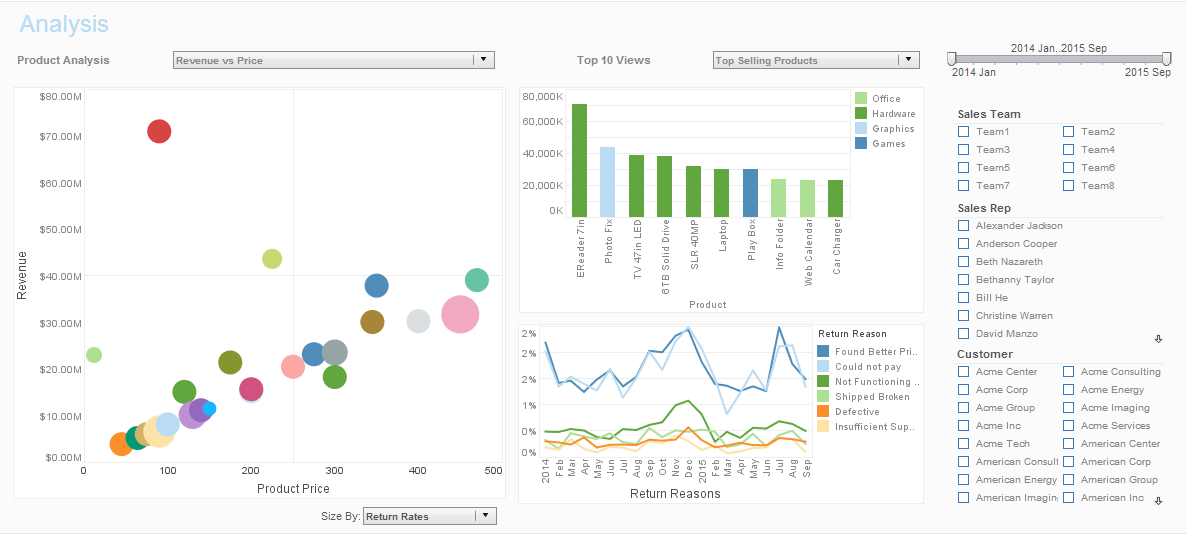What Are the Steps to Deploying Self-Service BI?
This is a continuation of the transcript of a Webinar hosted by InetSoft entitled "Why Self-Service BI?" The speaker is Mark Flaherty, CMO at InetSoft.
Mark Flaherty (MF): There are four basic steps. The first step is an assessment of your existing landscape with respect to people, processes, technology, and goals. Examine the information delivery capabilities that you have and the associated architecture. Inventory the data available from looking at system documentation, interviewing subject matter experts, and users of current BI reports.
The second step is identifying the business units across the organization that access information from the existing BI environment. If you are talking about a very large enterprise, then form a focus group of 10-12 people, getting people who are representative of each business unit. Solicit suggestions and comments about the current BI environment, what users are lacking now, where is there inefficiency with working with the current environment, etc. From these observations you can focus on the area and types of data that will benefit first from enabling self-service access to them.
The third step is to define the technology to deliver the self-service BI capability. From the landscape assessment and user interviews you start to plan how the needs can be consolidated into a single BI environment and solution. This step usually translates into architectural changes in data management including data warehouse changes, if a data warehouse exists. If there already happen to be several BI tools in use across the organization, a single vendor standardization approach can be beneficial. And if none of the existing tools are capable of delivering the envisioned self-service functions, then construct the business case for the selection of new one, such as InetSoft's.
The fourth step, after the selection of the software, is to create a phased roll-out plan with a goal of getting some deliverables completed sooner, rather than trying to address all the requirements and projects across the organization at once. With quicker success, the project keeps moving and avoids the risk of getting bogged down.
What are some of the challenges organizations face when trying to move to a self-service BI model?
You need to create an information-centric culture. And to do so it is critical, but also challenging, to create a strong data governance framework. The data governance framework should include master data management, metadata management, and data quality management.
Another area of challenge can be establishing processes for getting data. Sometimes people are used to getting the information they need quickly by asking special favors of people who have access to the data. Instead you have to create formal processes for that. The whole point of the self-service BI model is to reduce much of that, but you won’t be able to eliminate it entirely since you can’t anticipate changes in business needs or types of data that will be collected in the future. So you set up a process for collecting those requests, prioritizing, assigning, and scheduling them.
Case Study: Implementing Self-Service Business Intelligence (BI) at the Indonesia Stock Exchange (IDX)
The Indonesia Stock Exchange (IDX) is the primary securities exchange in Indonesia, facilitating the trading of stocks, bonds, and derivatives. As one of Southeast Asia's fastest-growing markets, IDX needed to enhance its decision-making capabilities to keep up with increasing trade volumes, market volatility, and regulatory requirements. Executives at IDX required a real-time, data-driven approach to assess market performance, detect anomalies, and strategize growth.
Challenge
Before implementing self-service BI, executives at IDX relied on manual reporting prepared by data analysts. The traditional reporting system had several challenges:
- Time-consuming reports: Executives had to wait for data teams to process requests.
- Limited real-time insights: Reports were often outdated by the time they were reviewed.
- Dependence on IT: Any modifications or new queries required IT intervention.
- Lack of interactive analysis: Static reports limited executives from drilling down into data.
To address these issues, IDX sought a self-service BI solution that would enable executives to access and analyze data independently, reducing reliance on IT and improving decision-making speed.
Solution: Implementation of Self-Service BI
IDX adopted a self-service BI platform that integrated data from multiple sources, including:
- Trading systems
- Market surveillance platforms
- Regulatory reporting systems
- Financial performance dashboards
Key features of the implementation included:
- Interactive Dashboards: Executives could now visualize key performance indicators (KPIs) such as trading volume, liquidity metrics, and market trends in real time.
- Data Mashup Capabilities: Using BI tools, data from multiple sources was merged for comprehensive insights without requiring manual data aggregation.
- Natural Language Querying: Non-technical executives could ask business-related questions and get insights without needing SQL expertise.
- Automated Alerts: The system notified executives of unusual trading activity, regulatory risks, or sudden market movements.
- Cloud-Based Accessibility: IDX executives could access dashboards remotely, enabling faster responses to market conditions.
Results
The implementation of self-service BI brought significant improvements:
- 80% Reduction in Report Turnaround Time: Executives no longer needed to wait for IT or data analysts for critical reports.
- Enhanced Decision-Making: Real-time insights allowed for faster and more informed strategic decisions.
- Increased Efficiency: Business users could independently generate reports, reducing IT workload.
- Improved Regulatory Compliance: Faster access to compliance data helped IDX respond promptly to regulatory changes.
- Better Market Monitoring: Executives could proactively identify trends and anomalies, improving market stability.

